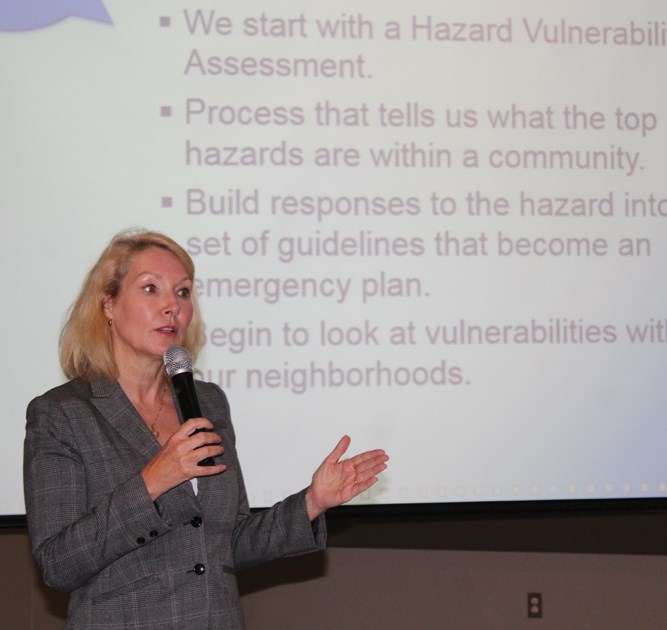What does it mean to ‘shelter in place’? Have you made plans for your livestock or pets in the event of an evacuation order? Stay tuned!
These were questions posed by Shelly Napier, the Winnipeg-based consultant hired by Westman Emergency Group (WEG) who spoke at a public information meeting Wednesday, April 17 in Virden.
Napier said, “Communities must … educate their residents in emergency management and let them know what plans are in place for them. So your community is doing that tonight, here in this room.”
However, of the nearly two dozen people attending the presentation there were very few members of the general public in the room.Most were municipal officials from the RM of Wallace-Woodworth and Town of Virden.
WEG’s coordinators, retired RCMP officer Matt Hipwell and co-coordinator Marc Savy, were present. As part-time employees of WEG, both see a significant task ahead of them in finalizing the plan, contacting past volunteers and organizing volunteer groups.
At this meeting they got the low-down on how to work with CN Rail if an incident involving a train demands emergency response.
The rail line stands among a list of potential hazards within the community; and along with a long list of dangerous goods that railways transport, such as petroleum crude oil, liquid ammonium nitrate and chlorine, there is a precise tracking process.
CN Rail Senior Dangerous Goods Officer Steven Santelli explained the detailed order of response for any incident, from the moment of a train derailment through clean-up - a PowerPoint presentation geared for municipal officials, firefighters and first responders.
Santelli said that in response to a serious derailment incident CN has many resources that that can be drawn on. “The thing we can’t do as a private company, is tell you to evacuate, or shelter in place.”
With the blast of a train going through Virden in the background, Santelli listed the vast assets available through CN’s emergency response, including the expertise to deal with plumes of poison gas that could be released in a train derailment. He said, “We’re here to help, we’re here to train… please use our assets, we’re here for you.”
For citizens, he also pointed out there is a phone number listed on every rail crossing for the CN Police, should there be something to report: 1-800-465-9239.
Emergency plan
Shelly Napier works with the WEG coordinators to put a detailed emergency plan in place for Westman. In her presentation she explained the role of Council, the CAO, WEG coordinators and why it’s vital to have a trained crew of volunteers to put the emergency plan into action.
“We don’t think about what it would meant to our community if there was a train derailment with chemicals and those chemicals caused a plume. And, if the emergency coordinators sitting at this table (pointing to Hipwell and Savy) had to use the plans that are put into place.”
In that event, shelter in place means that doors and windows need to be sealed, air conditioners/furnaces must be shut off and you may need to say inside for up to 72 hours.
“But I can tell you that your councils, your CAOs and your coordinators have to adhere to a program that is legislated by the government.” It is a program that relies heavily upon volunteers.
Public education is a strong component in an emergency plan, Napier stressed. Beyond a dangerous goods rail incident, emergencies could be a winter power outage in -40C weather, a snow storm, tornado, fire or flood.
Using her own example where their brand new furnace failed in the dead of a Winnipeg winter, she said that her family of five included a cat that had to be evacuated. Fortunately, they went to nearby family members. But, looking around her residential bay she realized there were at least eight households that, in a broader emergency, would need help with evacuation.
“There are other considerations in the light of power outages, such as “snowbirds” whose homes would be unattended…. When you get where council tells you to go and they don’t accept pets, what do you do then?”
Volunteers needed
WEG citizen-volunteers will be organized into working groups. Napier says there will be another meeting in May and she called for a show of hands, asking who would be able to commit to just two 2-hour sessions twice per year. Eight hours of training per year.
Days later, co-ordinator Hipwell estimates that between half and a third of the volunteers needed had been registered.
“Yes, we require more volunteers, in particular those who can work in the Emergency Operations Centre to assist with documenting the emergency as scribes and… monitoring communications,” he says.
He says many volunteers from past years are prepared to continue with the emergency group. They are also looking for people who can work as venue security for evacuees.
“If anyone wants to assist, we will not turn them away. Volunteers can contact us through either the R.M. or the Town offices, and soon through our WEG Facebook page.”
Napier says people will find a sense of community when they volunteer with the emergency group. “I’m going to come back in May [for a training session]. Even those who are not sure about the commitment, but still want to come to the training and then think about it, they can leave their name with Marc or Matt.
She also challenged people to bring one person with them to that training.




